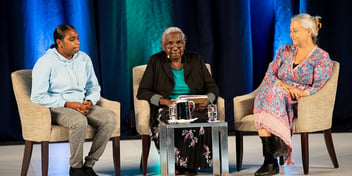Improving water quality in one of the NT’s most remote communities
Improving drinking water quality in one of the Northern Territory’s most remote communities required an emphasis on community engagement, innovation and imagination.
Upgrading the Borroloola water treatment plant was six years in the making for Power and Water Corporation Senior Project Manager Eric Vanweydeveld.
Although Power and Water had always supplied the town of 1000 people with potable water that met Australian Drinking Water Guidelines, Vanweydeveld said the groundwater was quite acidic, which meant it was damaging the water supply infrastructure.
The low pH and corrosive tendencies of the water also affected the chlorination, which impacted on the delivery of safe drinking water to the community.
Vanweydeveld began work on the project in 2012 with an initial investigation before getting approval to proceed with works in early 2017. The $6.4 million Borroloola water treatment plant was then officially opened in October this year.
The new plant is designed to supply the residents of Borroloola with up to 3ML of drinking water per day. Raw water from local bores is aerated through a degassing tower to remove the majority of carbon dioxide before being by the addition of calcium carbonate through two calcite filters.
The water is then disinfected by a new gas chlorination system and distributed through the network.
“The upgrade was about providing reliable and safe water, but it also provides water security for the town for the next 30 years, with the opportunity to connect neighbouring communities to significantly improve standards in the area,” Vanweydeveld said.
 Power and Water Senior Project Manager Eric Vanweydeveld.
Power and Water Senior Project Manager Eric Vanweydeveld.
Working remotely
While Borroloola has the basics – a few shops, a health centre, school, post office and police station – anything more specialised generally requires a trip to the nearest major centre, Katherine, which is about 700 kilometres away.
Vanweydeveld said working in such a remote community comes with a unique set of challenges. Already difficult to get to, it becomes near impossible to access during major weather events like cyclones or a massive storm.
“Borroloola is so remote, and the treatment plant site itself is remote compared to the town,” he said.
“This makes the social, environmental and geographical elements of the project very complicated … You have to come up with different strategies and have a bit of imagination to overcome some massive challenges.”
To begin with, finding a specialised contractor to carry out the work was difficult. Vanweydeveld said 13 potential contractors were taken to Borroloola to examine the challenges firsthand, but in the end only two bid for the project, with a joint venture between Suez and Darwin-based construction company Goodline selected.
And the logistical challenges didn’t end once the contract was awarded. The project team was spread across five locations, with Vanweydeveld in Alice Springs, Suez’s design team in Sydney, the plant operator in Borroloola and the rest of the team in Katherine and Darwin.
 The new Borroloola water treatment plant.
The new Borroloola water treatment plant.
To address this, the plant was designed using 3D. This allowed the project team to review the plans before meeting for a series of 'walk through' workshops.
“The idea of using a 3D model was to fast-track the design and to correct conflicts between disciplines that are not easily seen in the conventional 2D design,” Vanweydeveld said.
“Instead of sending everyone 200 2D drawings, the strategy was to get everyone together in the same room for a day and identify any issues.”
A ‘plug and produce’ plant
Power and Water also took an innovative approach to constructing the plant, using a ‘plug and produce’ modular system designed to fit in shipping containers.
The plant’s components were assembled, connected and pre-tested in Darwin before being sent to Borroloola via road train for the commissioning.
Aside from providing cost savings – the price of concrete in Borroloola is about five times that of Darwin – it was also easier to deal with contingencies such as a malfunctioning part.
“It was easier to do the construction in Darwin because it has all the supplies. It’s a day of travelling to get to Borroloola by car and it’s very expensive to charter a plane, so to limit the risks and cost, we decided to go with this approach,” Vanweydeveld said.
Community centred
While the design and construction of the plant required innovation, Power and Water went back to basics with its approach to community engagement. It used local contractors where possible – who Vanweydeveld described as the “fabric” of the project – and worked with the local school to keep the community informed about what it was doing and why.
“Because the water supply and wastewater network is underground, people don’t realise what they’re getting, so it was important to promote the project and explain how the water supply works,” Vanweydeveld said.
 Local kids provided artwork for the treatment plant.
Local kids provided artwork for the treatment plant.
Power and Water also worked with Borroloola’s Indigenous art centre and the school to create a series of children’s paintings that related to water and reflected Aboriginal culture, which were then blown up and displayed on the treatment plant.
Vanweydeveld said this helped connect the people of Borroloola to the project.
“They really embraced it … The kids were amazed at what we had achieved and there was a real connection with people,” he said.
Vanweydeveld has previously worked for Hunter Water Corporation in New South Wales and Veolia Water in France, and said his current role – and the Borroloola project in particular – was the most satisfying yet.
“I’ve had a few different experiences; this one is very challenging but also fulfilling,” he said.
“It was a once in a lifetime project to work on. It’s very unique – there were a lot of innovations and we were able to really push the limits.”

